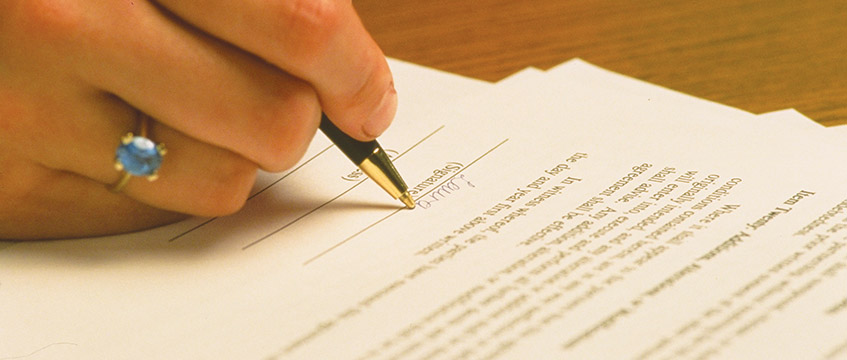Jonathan Seitler QC guides practitioners through the basics of the law relating to rectification of documents (such as leases) on the grounds of mistake.
Can an agreement be altered after it has been made?
Agreements are not rectified. But documents which purport to record agreements can be rectified if they do not accurately record what was actually agreed.
In American Airlines v Hope [1974] 2 Lloyd’s Rep 301, Lord Diplock said that “rectification is a remedy which is available where parties to a contract, intending to reproduce in a more formal document the terms of an agreement upon which they are already ad idem, use in that document words which are inapt to record the true agreement reached between them.
The formal document may then be rectified so as to conform with the true agreement which it was intended to reproduce, and enforced in its rectified form”.
In Kilcarne Holdings Ltd v Targetfollow (Birmingham) Ltd [2004] EWHC 2547 (Ch), Lewison J said that “rectification does not alter the bargain itself; it merely alters the written record of the bargain.”
In what circumstances can a document be rectified?
All types of mistakes in documents such as contracts and leases can be rectified, whether the mistake is a misdescription, such as specifying “landlord” in a lease when the parties meant “tenant” (Littman v Aspen Oil (Broking) Ltd [2005] EWCA Civ 1579) or missing out words entirely, such as in Cherry Tree Investments Ltd v Landmain Ltd [2012] EWCA Civ 736; [2012] 2 EGLR 141.
There are two situations in which rectification would be ordered. The first is where there has been a “common mistake”. This arises where both parties proceed on the same mistaken basis, ie both of them think that the document reflects what they are agreeing to, but they are both wrong and it doesn’t.
The second is where there has been a unilateral mistake. This arises where one party stands by and knowingly and unconscionably allows or encourages the other to fall into error.
What are the elements of common mistake?
To rectify a document purporting to record an agreement on the basis of common mistake, it is necessary to prove five things:
- that each party, objectively viewed, had a continuing common intention in regard to the terms of the agreement;
- that that intention continued up to the time when the document that purported to record it was executed;
- that the common intention was manifested in some objectively observable way (it does not have to be a prior agreement);
- that the executed document, again, objectively viewed, does not represent that true common intention;
- that it would, if it were rectified in a specific, identifiable way.
See Chartbrook Ltd v Persimmon Homes [2009] UKHL 38; [2009] 3 EGLR 119. In practice there must really be no doubt as to what the common intention actually was: it is not practicable therefore to plead two alternative, inconsistent “real” common intentions.
The extent of the rectification (though not necessarily the exact words) should be clearly ascertained and defined by the contemporaneous evidence.
What are the elements of unilateral mistake?
There are five elements to unilateral mistake:
- that there was a mistake by the party seeking rectification which meant that such party’s intention was not reflected in the document;
- that there has been no mistake by the party against whom rectification is sought;
- that the party who was not mistaken had actual or Nelsonian (shutting eyes to the obvious) knowledge of the mistake. A party seeking rectification for unilateral mistake therefore has to prove that the defendant knew of the claimant’s mistake and took advantage of it. Lack of diligence on the part of the defendant or its agents, which led it to be unaware of the mistake, is not enough;
- that the mistake is one which benefits the party who was not mistaken; and
- that it would be unconscionable for the party who was not mistaken to take advantage of it. So where a landlord and tenant were supposed to be extending a lease on the same terms and the landlord’s solicitor mistakenly slipped in a tenant’s break clause which the tenant’s solicitor noticed but chose not to raise, the landlord, almost six years later, successfully sought rectification of the lease documentation: Coles v William Hill Organisation Ltd [1999] L&TR 14; [1998] PLSCS 78.
In A Roberts & Co Ltd v Leicestershire County Council [1961] Ch 555 Pennycuick J summarised the principle in these terms: “…a party is entitled to rectification of a contract upon proof that he believed a particular term to be included in the contract, and that the other party concluded the contract with the omission or a variation of that term in the knowledge that the first party believed the term to be included.”
How hard is it to obtain an order for rectification?
It used to be thought that a person seeking to establish a case for rectification must establish his case by “strong irrefragable evidence” (Lake v Lake [1989] STC 865 at 869, per Mervyn Davies J) but following Re S-B (Children) (Care Proceedings: Standard of Proof) [2009] UKSC 17, the better view is probably that there are no distinctions in the standard of proof across civil cases. However, credible evidence will still be needed to overcome the evidence of the written document: see Tartsinis v Navona Management Co [2015] EWHC 57 (Comm).
How is a mistake in a document “rectified by construction”?
Mistakes in the wording of documents may sometimes be “cured” by construing the document without the need to resort to rectification: see East v Pantiles (Plant Hire) Ltd [1982] 2 EGLR 111.
In KPMG LLP v Network Rail Infrastructure Ltd [2007] EWCA Civ 363, Carnwath LJ observed that “there is no dispute that as part of the process of construing a contract, the court can correct obvious errors.”
Therefore, where the wording of an agreement is obviously mistaken, the
court may, by seeking to make sense of the commercial purpose of the agreement or by implying words necessary to make business sense of the bargain, in effect “rectify” the mistake.
In Great Bear Investments Ltd v Solon Co-Operative Housing Services Ltd [1997] PLSCS 327 there was machinery for rent review in the lease but it only required the tenant to pay, after review, “a rent equal to the rent previously payable or such rent as is reviewed”. The landlord did not seek the remedy of rectification as such, but rather invited the court to allow rectification by construction, by implying the words “whichever is the higher”.
The court held that this was permissible where: (a) it was clear that a mistake had been made; and (b) a reader with sufficient experience of the sort of document in issue would inevitably say to himself, “of course X is a mistake for Y”. The insertion of the words “whichever is the higher” passed each of those tests.
The doctrine of rectification by construction, however, does have limitations. In Scottish Widows Fund & Life Assurance Society v BGC International [2012] EWCA Civ 607; [2012] PLSCS 103 these were set out by Arden LJ to include the following: “i) it must be clear from the document interpreted with the admissible background that the parties have made a mistake and what the mistake is; ii) it must be clear from the rest of the agreement interpreted with the admissible background what the parties intended to agree; iii) the mistake must be one of language or syntax. It follows that it is not enough that the parties have mistakenly failed to provide for a particular circumstance. For the court to correct that error would be to rewrite the parties’ contract and to step beyond the permissible limits of interpretation.”
Is rectification allowed only between the original parties to the document?
No. A claim to rectification may also be made by a successor in title to an original party. The benefit of the right to rectify passes to successors in title: see Berkeley Leisure Group v Williamson [1996] EGCS 18.
The corollary is that an order for rectification might be refused if it would be to the substantial and unfair detriment to a third party: see Hawksford Trustees Jersey Ltd v Stella Global UK Ltd [2011] EWHC 503 (Ch).
What is the effect of an order for rectification?
In most cases, the rectification has retrospective effect so that the rectified document is treated as if it had always been in its rectified form. Land contracts are an exception: in such cases the court has a power and discretion concerning setting the date when the change has effect.
An order of the court for rectification would be a sufficient but not necessarily necessary precursor to an order for rectification of the register under the Land Registration Act 2002. Schedule 4 of that Act contains powers of the court and tribunal to alter the register for the purpose of correcting a mistake, bringing the register up to date or giving effect to an interest, estate or right excepted from the effect of registration.
A clear, concise yet scholarly treatment of this tricky area appears at www.linkedin.com/pulse/tricia-hemans-julia-petrenko-alteration-land-register-falcon-chambers by Tricia Hemans and Julia Petrenko.
What is the limitation period for rectification claims?
As an equitable remedy the position is covered by the doctrine of laches. This means, in effect, that a party will be barred from seeking rectification if it has “sat on its hands”.
It is also important, because rectification is an equitable remedy to which the claimant comes with clean hands. Relevant hands must therefore neither be dirty nor have been sat on.
Checklist
- Can an agreement be altered after it has been made?
- In what circumstances can a document be rectified?
- What are the elements of common mistake?
- What are the elements of unilateral mistake?
- How hard is it to obtain an order for rectification?
- How is a mistake in a document “rectified by construction”?
- Is rectification allowed only between the original parties to the document?
- What is the effect of an order for rectification?
- What is the limitation period for rectification claims?
Main image: Jim Pickerell/Rex/Shutterstock
Jonathan Seitler is a barrister at Wilberforce Chambers











